- The CPU performance of Snapdragon X Elite and Apple M3 Pro is nearly matching, however, in terms of performance-per-watt, Apple has a slight lead.
- The Adreno GPU on X Elite doesn't outrank the Apple M3 GPU, however, it competes with the older Apple M2 GPU.
- In terms of NPU performance, the Snapdragon X Elite seems far more capable than Apple M3's Neural Engine.
the entire lineup of snapdragon x series processors has been announced. among them, the snapdragon x elite processor, particularly the x1e-84-100 variant is the most powerful chipset. it features 12 oryon cpu cores, clocked up to 4.2ghz. so in this post, we compare the snapdragon x elite vs apple m3 with deep analysis of cpu, gpu, npu, and more. in addition, we have compared benchmark scores of snapdragon x elite and apple m3. on that note, let’s jump in.
note: snapdragon x elite’s top-end variant (x1e-84-100) features 12 cpu cores. so for better parity, we will be comparing qualcomm’s pc chipset with the apple m3 pro that packs 12 cpu cores.
specification comparison
| snapdragon x elite (x1e-84-100) | apple m3 pro | |
|---|---|---|
| fabrication process | tsmc’s 4nm | tsmc’s 3nm |
| transistors | not known | 37 billion (m3 pro) |
| cpu cores | 12 cores | 12 cores on m3 pro |
| cpu cluster | 12x high-performance cores | 6x high-performance + 6x efficiency cores |
| max frequency | up to 3.8ghz dual-core boost up to 4.3ghz | up to 4.05ghz |
| gpu | new adreno gpu 4.6 tflops | apple’s next-gen gpu |
| gpu cores | not known | 14 or 18 cores |
| tdp | not known | not known |
| neural engine | hexagon npu 45 tops | up to 16 cores 18 tops |
| unified memory (ram) | up to 64gb | up to 36gb |
| memory bandwidth | 135gbps | 150gbps |
| ram type | lpddr5x | lpddr5 |
| connectivity | wi-fi 7 and bluetooth 5.4, le | wi-fi 6e and bluetooth 5.3 |
| modem | snapdragon x65 5g modem (optional and discrete) | na |
| others | av1 encode and decode | av1 decode |
cpu
let’s compare the cpu of the snapdragon x elite and apple m3 first. the snapdragon x elite is fabricated on tsmc’s proven 4nm process node. the chipset features 12 high-performance oryon cores and does not pack any efficiency cores. the snapdragon x elite has a maximum frequency of 3.8ghz and two cores can be turbo boosted up to a mighty 4.2ghz.

coming to the apple m3 series, and the m3 pro in particular, it is developed on the tsmc 3nm process node, which results in 37 billion transistors on a single die. just like the snapdragon x elite, the m3 pro also packs 12 cpu cores, however, it has two clusters featuring 6x high-performance cores and 6x efficiency cores. its cpu frequency is clocked up to 4.05ghz.
on paper, the snapdragon x elite looks more potent than the apple m3 pro as two of its cores can run at a slightly higher frequency. however, to get a clear picture, we need to look at the geekbench scores of snapdragon x elite and apple m3 pro.
snapdragon x elite vs apple m3: geekbench 6
we have not seen leaked benchmarks of the top-tier variant, snapdragon x elite (x1e-84-100) running on a consumer laptop so far. so we are going to use official benchmark scores from qualcomm’s reference device in this comparison.
as you can see, in the single-core test, the snapdragon x elite couldn’t cross the 3,000 mark despite running at a higher frequency of 4.2ghz. whereas, the apple m3 pro, while running at 4.05ghz, breached the 3,000 mark. it goes on to show that in single-threaded tasks, apple m3 still has the lead, but by a small margin.
single-core multi-core qualcomm crd
snapdragon x elite (x1e-84-100)2936 15440 apple m3 pro (12-core) 3040 15307 apple m2 pro (12-core) 2661 14634 apple m3 base (8-core) 2997 11617 samsung galaxy book4 edge
snapdragon x elite (x1e-80-100)2785 13925 microsoft surface laptop 6
snapdragon x elite (x1e-80-100)2745 13970 lenovo snapdragon-edition laptop
snapdragon x elite (x1e-78-100)2429 14079 qualcomm official score
snapdragon x plus (x1p-64-100)2425 13100
in the multi-core test, the snapdragon x elite did perform better than the m3 pro, but again by a slight margin. and yes, the top-end sd x elite variant indeed performs better than the apple m2 pro and base apple m3.
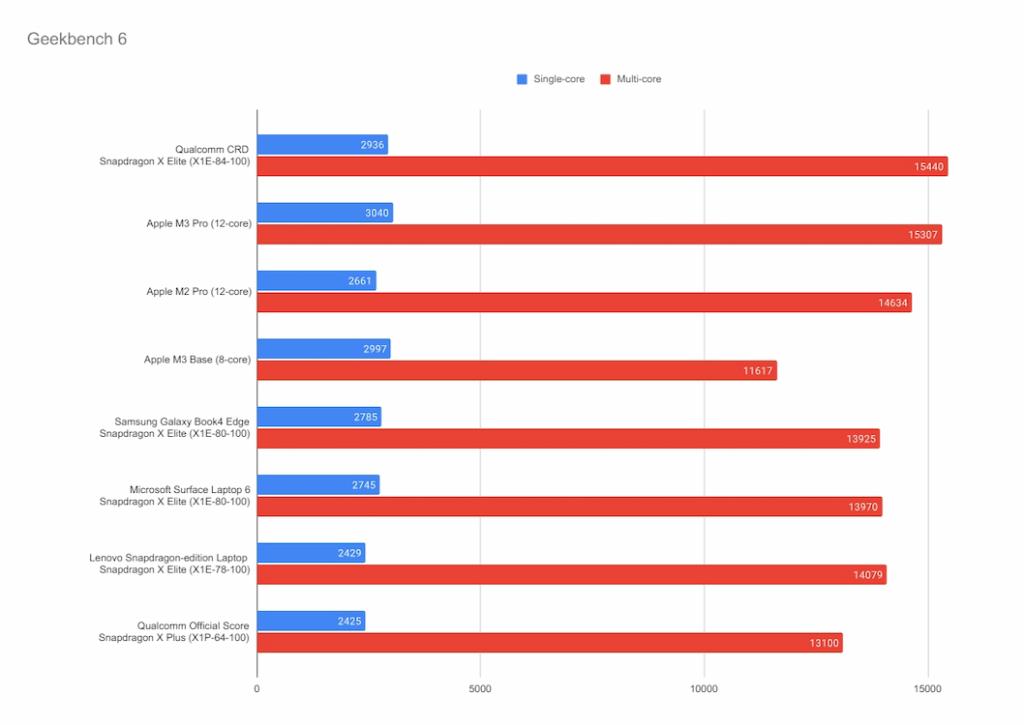
overall, i would conclude that both chipsets have powerful cpu cores and are nearly matching in performance. however, apple’s cpu cores are able to match performance while running at a lower frequency. it means that in terms of performance-per-watt, apple still has a slight lead.
snapdragon x elite vs apple m3: early benchmarks
while we are yet to test the snapdragon x elite, signal65 has done an early comparison between surface laptop 7th edition and macbook air m3. the analysis was commissioned by microsoft. the conclusion of the report is that snapdragon x elite is plenty powerful and outranks apple m3 in multi-core tasks. however, for single-core tasks, m3 is around 15% faster than x elite.
in terms of gpu, apple m3’s 10-core gpu is about 30% faster than snapdragon x elite’s adreno gpu. in npu performance, however, snapdragon x elite’s hexagon npu performs 2x better than apple m3’s 16-core neural engine.
the battery life is also quite good on the snapdragon x elite with active cooling support. the surface laptop 7 delivered about 21 hours of video playback on a single charge, outranking the macbook air m3 by 16%.
having said all of that, the thermal performance of x elite is slightly disappointing as it runs slightly hotter than macbook air. it requires active cooling and yet crosses 50 degrees c when the whole system is stressed for a long duration. the fanless macbook air m3, on the other hand, remained close to 45.8 degrees c.
gpu: apple or snapdragon?
in our comparison between a17 pro and snapdragon 8 gen 3, we found that 8 gen 3’s adreno gpu is both more powerful and efficient than apple’s new mobile gpu. but, does the adreno gpu have the prowess to defeat apple’s next-gen gpu developed on a newer architecture for m-series socs? let’s find out.
the snapdragon x elite comes with an integrated adreno gpu onboard. we don’t know the gpu core count, but the top-end variant (x1e-84-100) can perform 4.6 tflops, which is higher than the 10-core gpu on the base apple m2 chip (3.6 tflops).
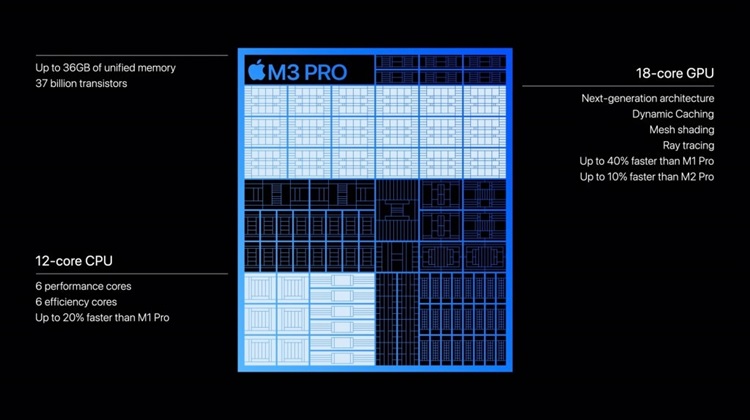
however, apple has taken its gpu to the next level this year with the m3 chipset. it has introduced a new gpu architecture and has also brought support for ray tracing and mesh shaders. not to mention, dynamic caching is supposed to make graphics performance even better on macos with proper memory management.
apple is planning to make macos a powerful gaming platform, which is something the cupertino giant has missed out on for many years. as things stand right now, the gpu on the apple m3 chipset seems to be powerful, and qualcomm needs to do more to entice the gaming community to move from x86 to an arm-based windows platform.
qualcomm recently said that windows games will work just fine on snapdragon x elite due to improved emulation, but will have to test it out before giving a final judgment.
having said that, qualcomm released some gpu benchmark numbers for the x elite in comparison to the older apple m2 chipset. the snapdragon x elite achieved 44.5 fps in the 3dmark wildlife extreme test whereas the apple m2 achieved 40.8 fps. in the aztec ruins benchmark test, the x elite scored 350 fps and the m2 scored 295 fps.
if we consider the geekbench gpu score of both chipsets based on the opencl api, it seems the adreno gpu is behind the apple m3 gpu. when compared to the apple m3 pro which packs 14 gpu cores, the difference becomes even more substantial. so yeah, the adreno gpu on the snapdragon x elite doesn’t beat the apple m3 gpu, however, it’s slightly better than the m2 gpu.
| geekbench gpu opencl score | |
|---|---|
| snapdragon x elite (x1e-84-100 ) | 23584 |
| apple m3 base (10-core gpu) | 25847 |
| apple m3 pro (14-core gpu) | 42768 |
ml and ai engine
as we transition to the ai age, the competition in the silicon industry is heating up to deliver the best on-device ai experience. qualcomm has packed its powerful hexagon ai engine on the snapdragon x elite and it can perform 45 tops (trillion operations per second) with the npu alone.
but what’s even more impressive is that when using all the compute units together including cpu, gpu, and npu, it can deliver up to 75 tops. not to mention, it can generate 30 tokens per second while running a 7b llm model.

in comparison, the 16-core neural engine on the apple m3 chipset can only perform up to 18 tops. it’s quite puzzling that apple’s a17 pro, a mobile chipset with 16 neural engine cores can perform 35 tops, but apple’s latest m-series processors are limited to just 18 tops.
however, with the m3 family, you get an option of 128gb unified memory to load large language models whereas you can only run models up to 64gb on x elite. simply put, in terms of on-device ai capability, the snapdragon x elite seems more capable than the apple m3.
memory speed comparison

the snapdragon x elite uses 16-bit 8-channel lpddr5x memory, and it supports capacity up to 64gb. it has a memory bandwidth of 135gbps. on the other hand, as we mentioned in our apple m3 vs apple m2 comparison, the memory speed has been downgraded on the m3 pro specifically.
apple is using a 192-bit memory bus (down from 256-bit), which reduces the lpddr5 memory bandwidth to 150gbps from 200gbps. despite all of that, you’ll get better memory speed on the apple m3 pro than the snapdragon x elite.
connectivity and more
the snapdragon x elite comes with the latest connectivity options. it includes wi-fi 7, bluetooth 5.4, and le support. laptop makers also have the option to add a 5g modem to bring an always-connected pc experience. qualcomm has said that its discrete snapdragon x65 5g modem can be paired with the snapdragon x elite.
not to forget, snapdragon x elite supports av1 encoding and decoding for efficient video streaming and processing. on the apple m3, you get wi-fi 6e and bluetooth 5.3 support, but there is no support for mobile connectivity on the go. you will get av1 decoding support, but can’t encode videos with av1 codecs.
has qualcomm finally beat apple?
as far as oryon cpu cores are concerned, it appears qualcomm has truly developed a powerful cpu and it rivals the apple m3 chipset. the nuvia team has managed to deliver powerful performance which is amazing. in the gpu department, qualcomm needs to make big changes to compete with a laptop-grade gpu. currently, it can only compete with the older m2 10-core gpu, which is not bad per se.
while qualcomm says that emulation has improved, the company along with microsoft needs to work with the developer community to bring native games to the arm platform. windows is already the choice for gamers, and if qualcomm wants to succeed and replace x86 as the preferred hardware platform, it needs to work on software compatibility.
finally, in the npu and connectivity departments, qualcomm is already leading the race and setting a benchmark for on-device ai experiences. overall, there’s just one conclusion that we can make; whether it’s qualcomm or apple, it’s time for arm to shine bright for years to come. what are your thoughts on this? let us know in the comments section below.









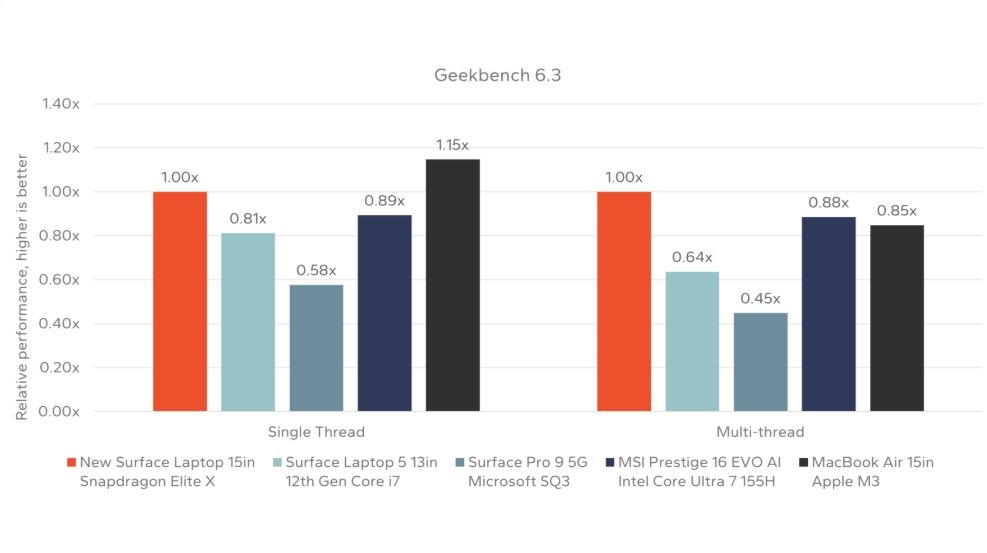
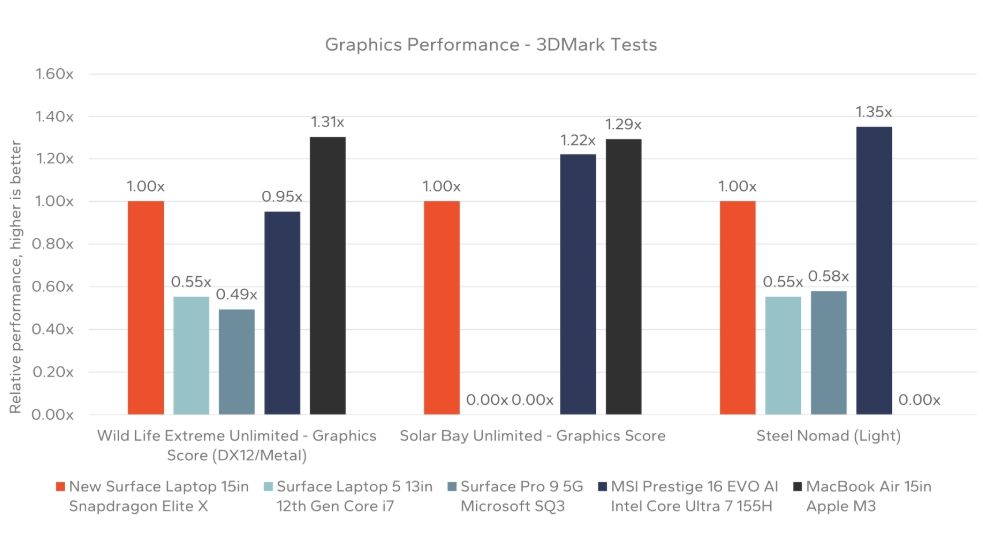
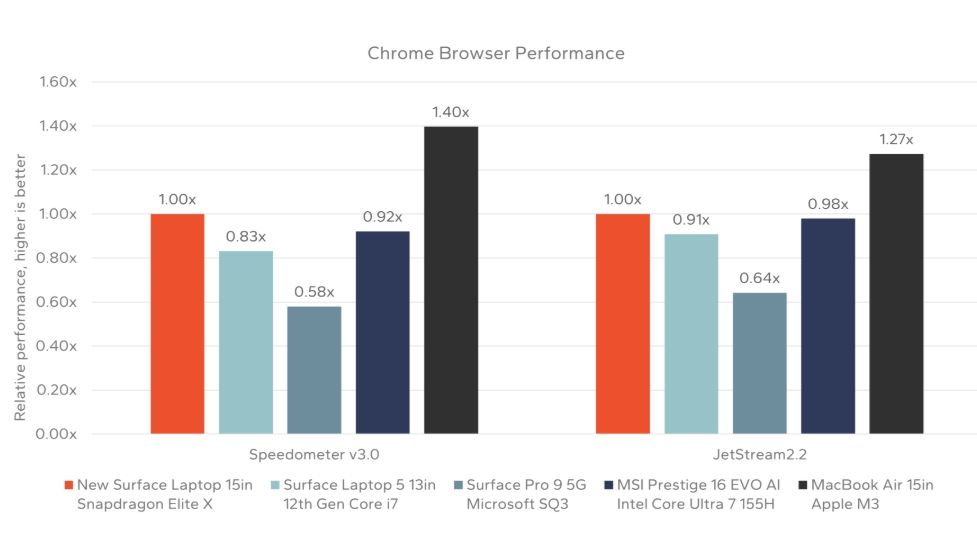



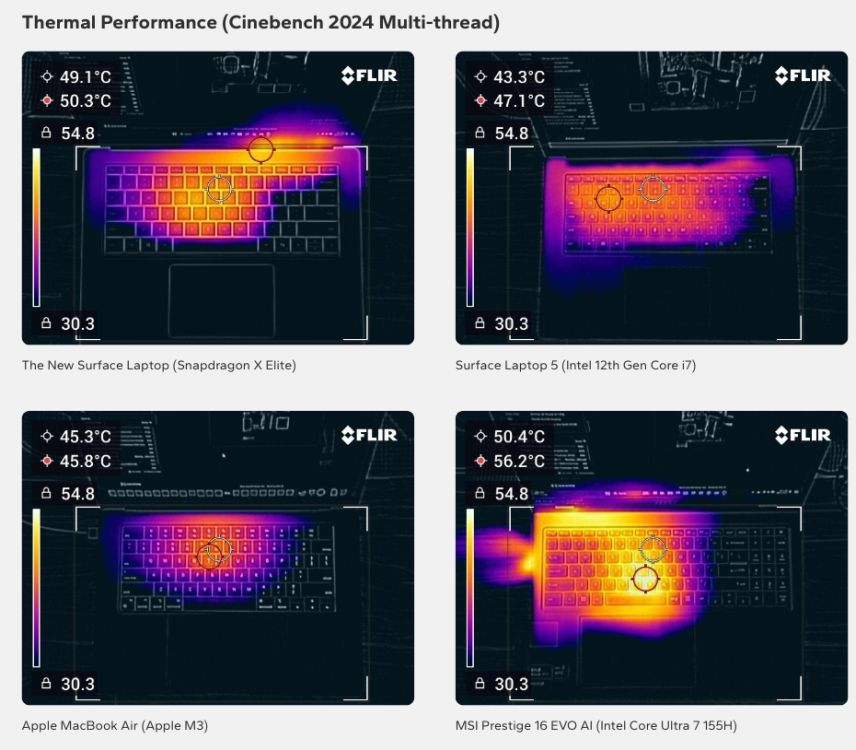

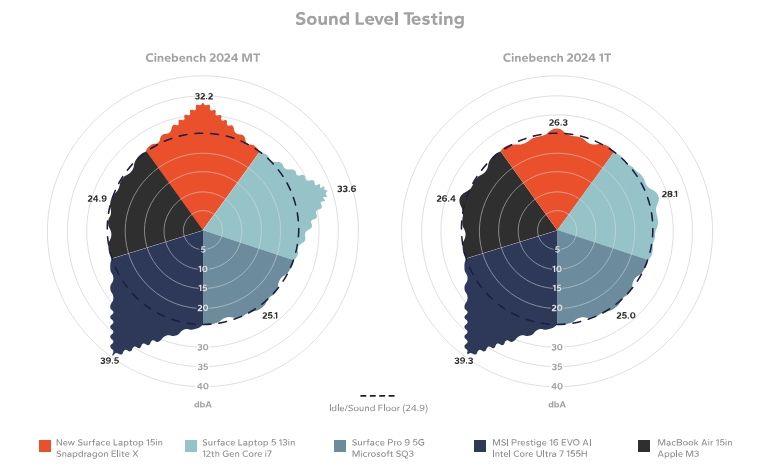
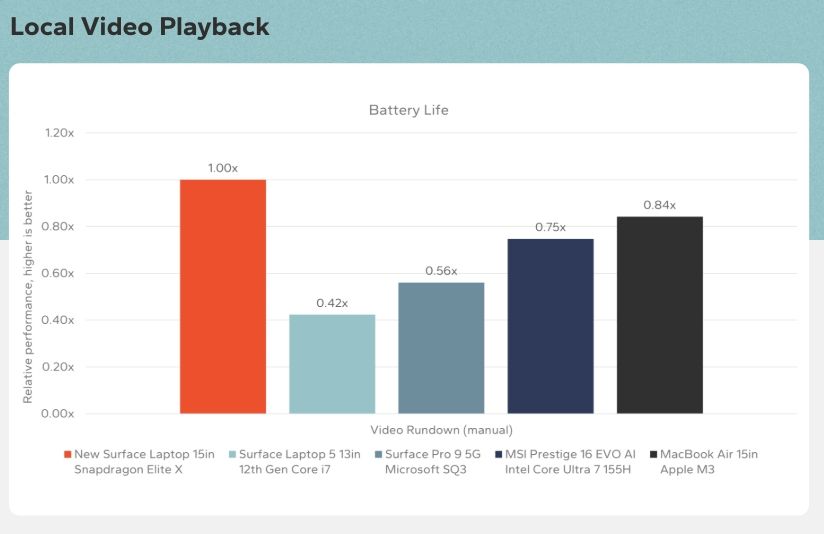
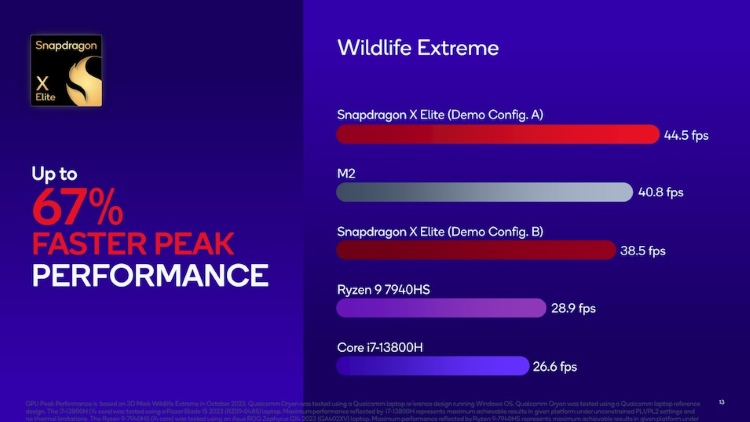
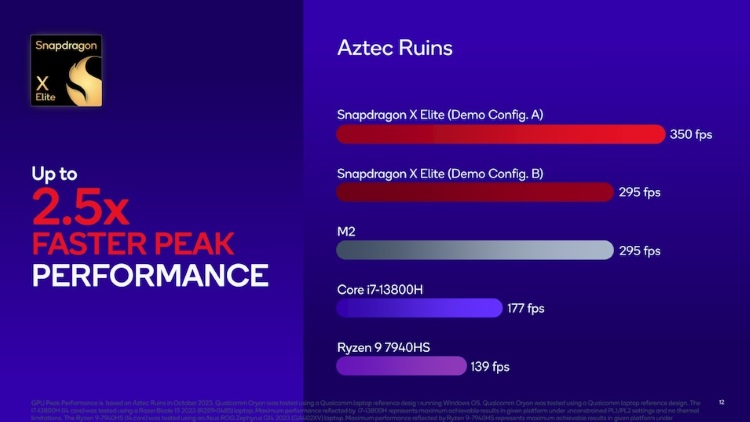











So you compared gpu between 20 Watt previous generation cpu and 80 Watt actual cpu?
Congratulations, good job!
benchmark not shown the real test.. intel i9 have better performance than M2 max cip, but still lost in some video and photo editing on a laptop.. ARM on windows is not like the x86 windows.. hope they can bring improvement.
Finally, the future of Windows on ARM looks very interesting. We might finally get iPad Pro-like performance on Windows tablets 🤞